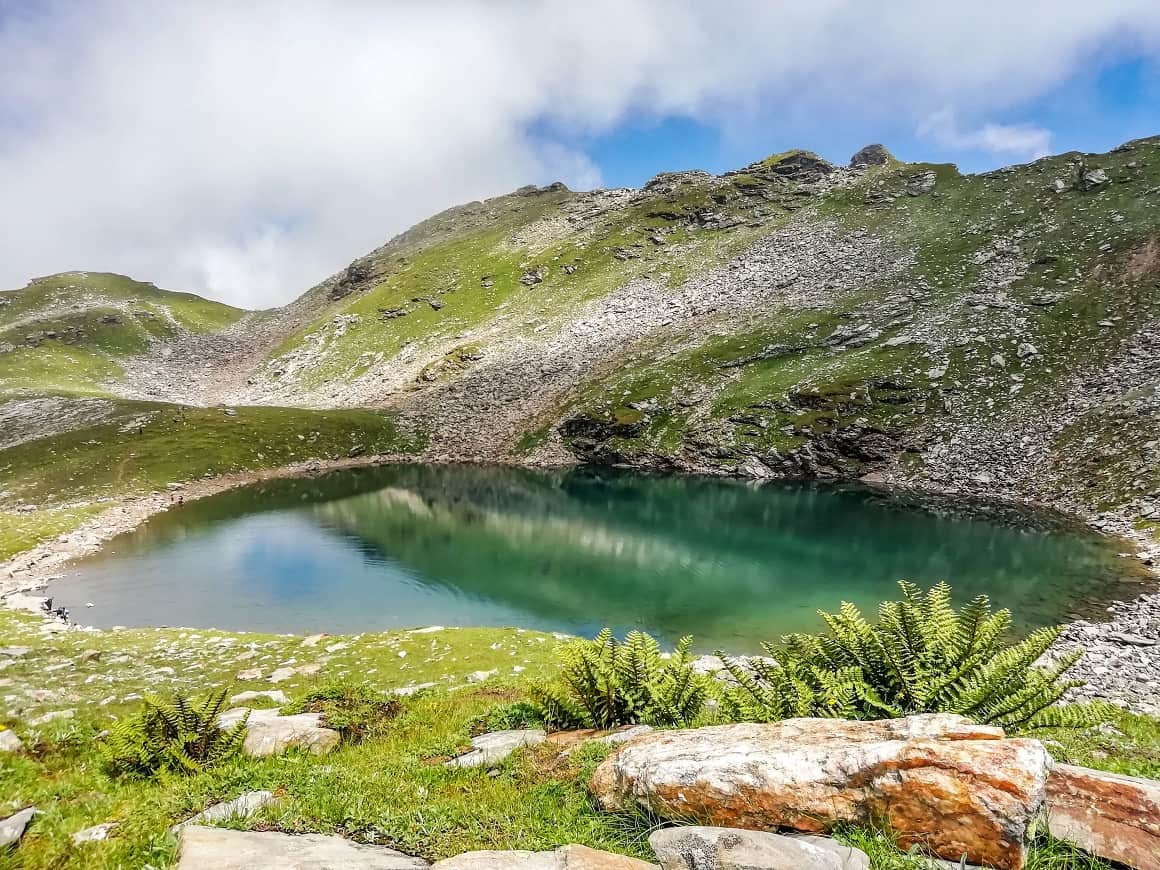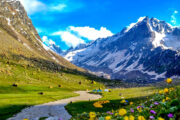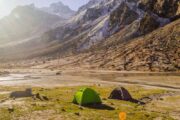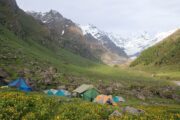Why It Is A Must-Do Trek?
is a high-altitude glacial lake located in the upper Kullu Valley on the eastern side of the popular Rohtang Pass in Himachal Pradesh. An ideal trekking opportunity for both beginners and seasoned trekkers as well as families, the Bhrigu Lake trek is full of nature rsquo s wonders. Perched atop an altitude of 14,000 ft, this trek offers stunning views of the alpine meadows and grasslands and you will catch glimpses of the seven sister peaks. The panoramic view of the snow-capped mountains and their reflections on the lake offers ample opportunities for the shutterbugs to capture nature in its full glory. The trek history is steeped in mythology. It is believed that the famous saint Maharishi Bhrigu used to meditate near the lake. The Lake is not the only major attraction in the trek but the beautiful grasslands that cover the valley are a treat of their own. Walk through tree covers and a moderately steep climb to enter into the grasslands and soon you will be left smitten at all the beauty that lies all around you.
Challenge 2: Continuous Ascent
Pick any Himalayan trek with lush meadows; it takes a long time to cross a forest section, traverse through a few plains and reach high ground. But, in a short trek like Bhrigu Lake, the forest section quickly ends and leads us into a wide meadow with steady ascends. There is not an inch of flat land for 7 km before Rola Kholi. This patch requires adequate leg strength to get through and reach the campsite for the day in time. Baby steps and a constant rhythm of waking are the tricks of the trade usually employed by experts for such terrain.
Challenge 3: Whiteouts
The cotton clouds of monsoon envelop the entire landscape of Bhrigu Lake within a matter of seconds. Walking through the mystical clouds is, without a doubt, a heavenly experience. But sometimes, the clouds get carried away to grow thicker and denser, reducing the visibility to zero. We have heard many stories of trekkers losing their way in the past. We would advise you to stay close to your trek leader or local guide during such whiteouts.
Drive from Manali (2050 M) to Gulaba (3,000M) and trek from Gulaba to Rola Kholi (3,810M)
Distance: 23 kms drive + 7 kms trek
Duration: 2 hours + 6 hours
Rola Kholi (3,810M) to Bhrigu Lake (4267 M)
Distance: 5 kms
Duration: 4 hours
Rola Kholi (3,810M) to Gulaba (3,000M)
Distance: 7 kms
Duration: 4 hours
Day 1-Drive from Manali (2050 M) to Gulaba (3,000M) and trek from Gulaba to Rola Kholi (3,810M)
Drive from Manali to Gulaba
Manali, the populous tourist town is the starting point for many treks in Himachal Pradesh like Beas Kund, Bhrigu Lake, and Hampta Pass. Manali main bus terminus is the assembly point where all trekkers are expected to arrive before 9 AM. We will do a quick headcount and start driving towards Gulaba. The drive from Manali to Gulaba is a fascinating journey. The 23 km to Gulaba should take us 2 hours to cover.
As soon as we start from Manali, for the first 20 minutes the roads will take you through the cultural lanes of Himachali tradition. Look out for the old heritage buildings, vibrant attires of the natives, and small flea markets on the corner of the streets. We can pick up some souvenirs at the end of the trip. As we pass through the huge metallic bridges to cross the Beas river, small twinkling stars will pop up and keep us company when the sun rays reflect on the mighty Beas river.
45 minutes into the drive, the Beas River will disappear behind us and we will enter into the famous Rohtang Pass. The road will divert to our right from the Rohtang Pass and enter into the Kullu district. Lush green and golden apple trees will wave their branches to welcome us on both sides of the roads. Once we cover a distance of 15 km, our vehicle will cross through fresh cotton clouds. It will cleanse our mind, body, and soul. During the monsoon season, we can witness the monsoon clouds joining together and making doodles in the sky. Keep your eyes peeled for the valiant hosts of Gulaba – The Vultures. They patrol the sky to keep us in check.
After 21 km, we will cross a government check post. They will take a headcount, check the necessary documents and allow us to go ahead. In 2 more km, we will reach the starting point of the trail – Gulaba.
Gulaba (3,000M) to Rola Kholi (3,810M)
Distance: 7 km
Duration: 6 Hours
The trail for the Bhrigu Lake trek begins from Gulaba. We will cross the road and start walking at around 11 AM. The water source for the day is small mountain streams between every 3 km and the terrain comprises of steep ascents and no descents.
In the beginning, for the first 30 minutes, the trails will be covered with dense oak trees, pine trees, Himalayan Birch, and shrubs. The mystic woods, moist leaves, and the hums of the insects will create a groovy song to keep us entertained. We jump, move and groove with the beat. The pathway will bend and twist like a snake and lead us through some water mist created from the monsoon clouds. (White-outs are a common factor in monsoon treks)
At the end of 2 km, the forest line ends and captivating grasslands take over the landscape. The rolling meadows extend for 5 km till Rola Kholi. Usually, it takes more time and a long distance to reach any Himalayan grassland from the base point of a trek. But on the Bhrigu Lake trek, it just takes 2 km and 30 minutes.
3 kms into the journey, the first water stream appears. We can fill our bottles and settle for lunch there. To make our journey more colourful, the terrain from the lunch point is completely covered with wildflowers. If we get lucky we can find some dry Dandelion flowers. Make a wish and blow it.
The sparkling colours of the flowers on the grassland fluctuate with different shades for the next 2 km. If we stop here and look back, we get a glimpse of the stunning Solang Valley and Beas Kund Valley. Once we cover a distance of 6 km in 5 hours, the pathway gets steeper and ascends towards the high ground. After finishing 7 km in 6 hours we reach a plain land near a big mountain stream. Thais is our Campsite for the day – Rola Kholi. Rola Kholi is a natural podium to stand and observe the stars and star dust in the night and witness the magnificence of Seven Sister Peaks, Deo Tibba, Solang Valley, Hanuman Tibba, and Beas Kund Valley in the day. The spectacles are bound to stay with us forever.
Day 2- Rola Kholi (3,810M) to Bhrigu Lake (4267 M)
Today, the terrain and the trails continue with challenging ascents and are covered in scree, boulders, and broken rocks. There are few water sources, so carry enough bottles to support yourself.
We leave our camp around 9 AM and carry packed lunch with us. We cross the stream next to the campsite and start ascending. Just 10 minutes after the first ascent, the land opens up to a huge boulder and a wider skyline. From this spot, we can get a clean and panoramic view of the Seven Sister peaks, Deo Tibba, Solang Valley, Hanuman Tibba, and Beas Kund Valley. The grasslands from the boulder point come under the shepherd’s domain. For the next 2 kilometres, we can see many horses and cows grazing over the fresh grass covered in dewdrops.
The green tinge of the grassland dilutes and disappears at the end of 2 km. A mix of wild grey and light brown colours take over the landscape. The nature of the trail completely changes here. Be prepared to cross over boulders, narrow ascents filled with scree and rocky pathways. It is best to be with the group and follow the instructions of your trek leader while trekking through these trails. Because of frequent whiteouts, people tend to lose their way and get stuck in-between the rocks.
After covering a distance of 4 km, the trails incline towards a 30-degree ascent for another 1 km. Look down for the small flowers that sneak out and flash their bling through the cracks of the boulders. It’s a masterpiece in the mountains. Finally, at the end of 1 km, we reach a high ground with a fabulous view of Bhrigu Lake. Bhrigu Lake is a beautiful marvel which changes its colour according to season. During monsoon and summer, it changes from olive green to emerald green. During the winters it completely gets frozen and turns into pearl white colour. We stop for lunch near the lake, spend some quality time there and start heading back towards the campsite in Rola Kholi.
Day 3- Rola Kholi (3,810M) to Gulaba (3,000M)
After dismantling the campsite and packing everything, we leave Rola Kholi at around 8 AM and reach Gulaba by 12 PM. The trail for today is less demanding with easy descents. A dedicated vehicle will pick us up from Gulaba and drop us back at Manali bus terminus around 2 PM. If you are traveling by flight, it is advisable to stay for the night, rest, and leave the next day. Manali roadways are prone to heavy traffic because of tourist attractions.
By Air :-
You can even take a flight to Bhuntar Airport but I would not recommend it because of the high prices of the flight and very high chances of cancellations. In case you do reach Bhuntar by flight, Manali is just a couple of hours away and you can easily get a bus or a private taxi till there. If you do plan to come via Bhuntar, make sure to reach at least a day before the trek starts.
By Train :-
Delhi to pathankot railway station is from where you can get direct buses to manali that is 300 km from there and would take an overnight journey.
By Bus:-
There is regular bus service from Delhi to manali, from Delhi to ISBT Kashmere Gate. We would suggest you to take only government buses from ISBT Kashmere Gate. Private buses ply from outside ISBT and they are not trust worthiness. Usually buses drop you at Dehradun ISBT. From there you have to come to Dehradun Railway Station
Includes
- Meals during the trek
- Dinner on arrival day in manali
- Forest Permits/Camping Charges (only if availing transportation through A1 Himalayas). Included only upto amount charged for Indian Nationals
- Tents, Sleeping bags, mats
- Safety Equipment includes static rescue rope, seat harness, carabiners, pulleys
- Trek guide, cook, helpers, porters & mules for carrying common luggage
- Services of a Certified Trek Leader
Excludes
- Meals during road journeys
- Transportation from manali to manali.
- Carriage of Personal Bags during the trek
- Any kind of Insurance
- Any expense of personal nature
- Any expense not specified in the inclusion list.
1) Trekking Shoe/Snow Shoe
2) Rucksack/Back Pack
3) Rucksack cover (Waterproof)
4) Daypack/Knapsack
5) Undergarments/Innerwear
6)Woolen socks
7) Woolen gloves
8) Waterproof gloves
9) T-shirt
10) Trek pants
11) Camp sandal
12) Balaclava/Woolen skull
cap/Monkey Cap
13) Sun cap/Wide-brimmed
Hat/Bandana
14) Walking Sticks/Trekking
Poles/Ski Poles
15) Heavy Jacket
16) Windproof Jacket/Wind
Cheater
17)Raingear/Poncho/Waterproof clothing
18) Water bottle/Hydration pack
19) Sunscreen lotion
20) Sunglasses
21) ChapStick/Cold &
Moisturizing cream
22) Toothbrush and toothpaste
23) Towel
24) Hand sanitizer
25) Tissue roll ( Toilet)
26) Anti Fungal Powder
27) Torch/Head Lamp with extra batteries
28) Knee cap
29) Camera with extra cells
30) Dry food items
31) Personal first-aid kit
32) Medicines (This is a simple
guide line and a doctor’s
consultation is recommended.)
Altitude is a risk. Before you begin the trek, you should be aware of the effects of high altitude on your body. Acute Mountain Sickness (AMS) symptoms include a moderate headache, nausea, and overall discomfort.
Reponse: If you have any of these symptoms, notify the trek leader immediately and follow his advice. To deal with the scenario, each campsite contains a stretcher, a fully prepared first aid kit, and oxygen cylinders.
Weather Risk : No one can guarantee snow, rain, or sunlight, even if we keep a constant eye on the weather. Please keep in mind that your safety is our primary priority, and if the weather isn’t cooperating, we won’t leave the campsite.
Response: The choice to go or wait for better weather will be made solely by the Trek Leaders and Guides.
Risk: Injury is a possibility. While trekking across difficult terrains, minor injuries such as calf sprains, bruising, and other minor ailments are prevalent. Serious injuries, such as fractures or significant cuts, are quite uncommon.
Response: All of our Trek Leaders are trained in wilderness first aid. They’ve been taught to deal with emergencies and have a well-stocked first-aid equipment to deal with minor injuries. In the event of major injuries, the patient is carried to the nearest road-head on a stretcher and taken to the nearest medical facility.
DO’S AND DON’TS ON A TREK
1. Alcohols or any other intoxicating products ‘’STRICTLY PROHIBHITED’’
during the trek.
2. Always pay heed to the trek guides or instructors.
3. Try not to leave the group under any circumstances.
4. Avoid trekking during the nights as it is extremely dangerous.
5. Avoid using earphones as that might hinder your hearing.
6. Do not participate or encourage littering of the places in any form.
7. While visiting the local villages and tourist sites, obey the local guidelines
and instructions.
8. Do not harm or interrupt the local sentiments of the places.
IMPORTANT:
Your safety is of paramount concern while traveling with A1 Himalayas.
Please note that your leader has the authority to amend or cancel any part of
the itinerary if it is deemed necessary due to safety concerns. Since adventure
entails traveling in remote mountainous regions, we cannot guarantee that we
will not deviate from it. Weather conditions, health condition of a group
member, unexpected natural disasters, etc., can all contribute to changes in
the itinerary. The leader will try to ensure that the trip runs according to plan,
but please be prepared to be flexible if required.




